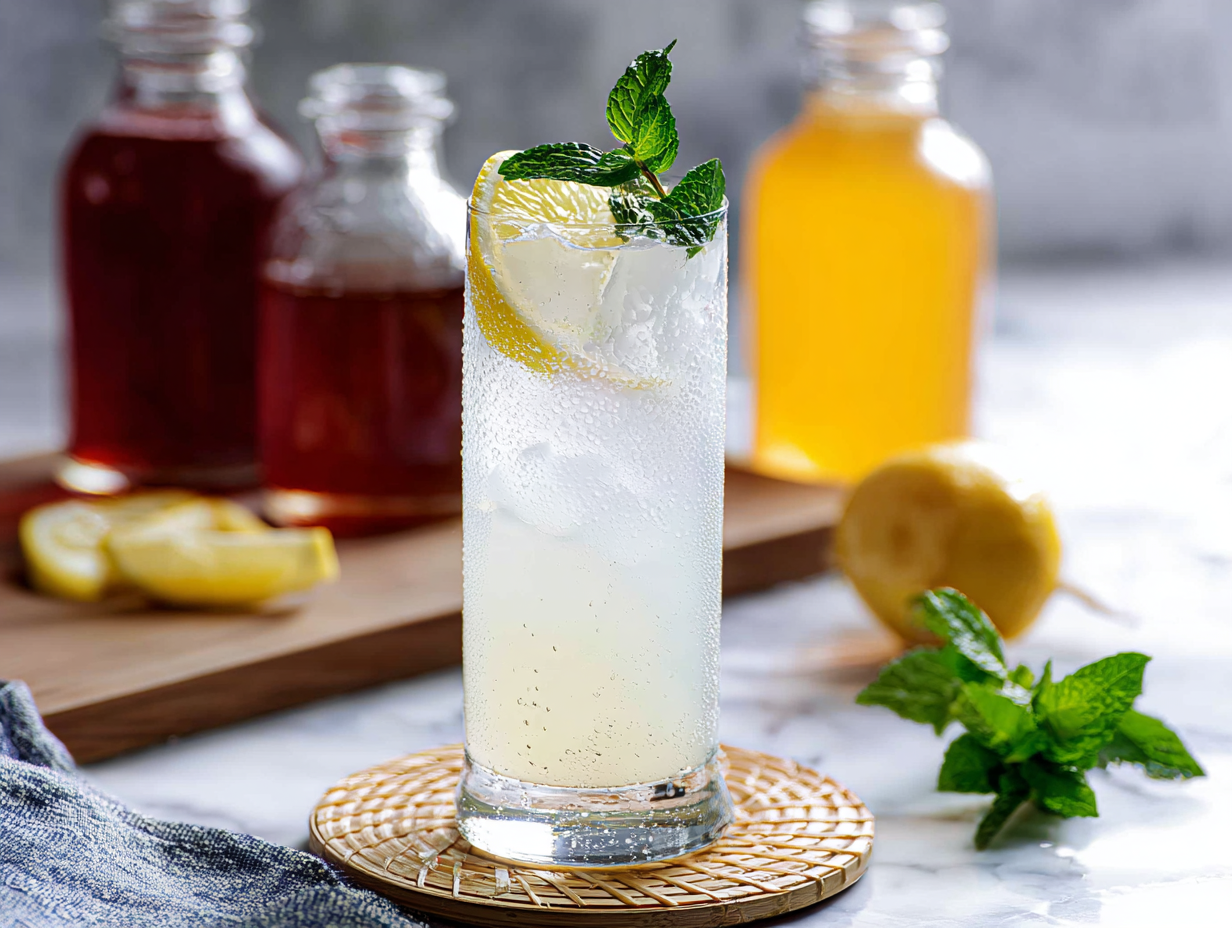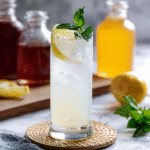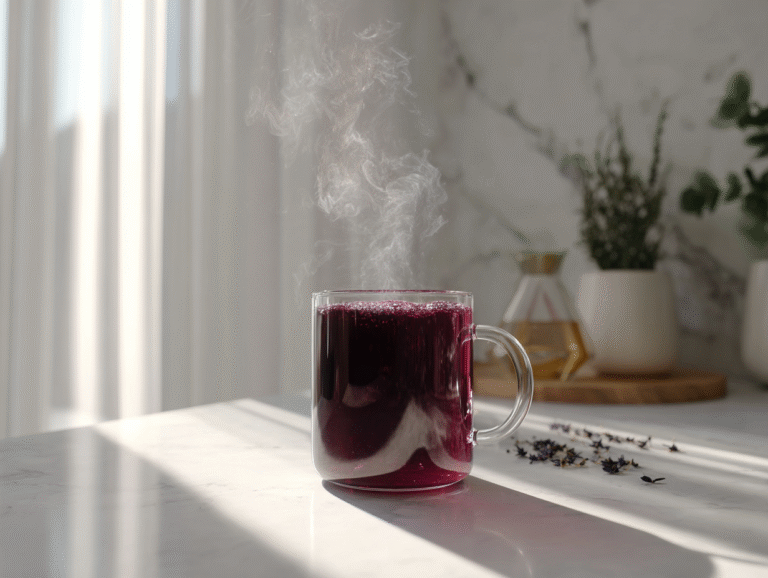How to Make Probiotic Soda with Ginger Bug (Easy & Healthy)
If there’s one thing I’ve learned in my Asheville mountain kitchen, it’s that fermentation has a way of connecting the past with the present. When I first stumbled across how to make probiotic soda, it instantly reminded me of my grandmother’s kitchen. She always had something bubbling on the counter — sometimes a jar of pickles, other times a crock of beans. Those fizzy, living foods had their own rhythm, and they taught me patience. Today, I carry that memory forward every time I feed my ginger bug and bottle a new batch of soda.
Homemade probiotic soda isn’t just about fizz. It’s about creating something alive, something that feels as comforting as fresh cornbread coming out of the oven. Using a ginger bug — a mixture of ginger, sugar, and water teeming with wild yeast and bacteria — you can transform simple fruit juice or tea into a bubbly, gut-friendly drink. Once you learn the process, you’ll realize that how to make probiotic soda is as easy as brewing coffee in the morning or stirring a pot of beans.
In a world overflowing with sugary sodas and artificial flavors, this simple tradition offers something real. You’re not just making a refreshing drink — you’re nurturing your body. Much like a glass of date seed coffee provides a wholesome alternative to store-bought lattes, probiotic soda offers a naturally carbonated option that supports digestion and balance. And if you’ve ever tried okra water for its benefits, you’ll appreciate how probiotic soda works in a similar way, gently boosting your health with every sip.
The first taste will win you over: crisp, lightly sweet, and fizzy enough to make you smile. That’s the magic my grandmother knew well — good food doesn’t need to be complicated, it just needs heart.
Understanding the Ginger Bug
If you’ve ever wondered why a jar of ginger, sugar, and water can bubble up with life, the answer lies in what we call a ginger bug. At its core, a ginger bug is a natural starter culture — a living mix of wild yeast and lactic acid bacteria that thrive on the sugars you feed them. When cared for, it becomes the foundation for ginger bug soda, a base you can use to ferment almost any fruit juice or sweetened tea into probiotic soda.
The process is simple, but also fascinating. Fresh ginger contains natural yeast on its skin. When you combine that ginger with sugar and water in a clean jar, you’re giving those microbes food and the perfect environment to grow. Every time you “feed” the bug with more ginger and sugar, you’re building a stronger, more active culture. Within a few days, you’ll see bubbles rising, hear faint fizzing, and notice a tangy aroma. That’s the sign your ginger bug is ready to transform ordinary liquid into something extraordinary.
So, how does the ginger bug actually create probiotic soda? Once added to sweetened juice or tea, the microorganisms begin consuming the sugars and releasing carbon dioxide, which gives the soda its natural fizz. At the same time, they produce beneficial acids and enzymes that are great for digestion. The length of fermentation depends on your taste: just a couple of days yields a lightly sweet soda, while a longer fermentation makes it tangier and more robust.
What makes this method so appealing is its flexibility. You can add your ginger bug to a cooling herbal infusion, like a soothing lemon balm recipe, or to something more unusual and bright, like a blue tonic. Both will ferment beautifully, giving you endless room to experiment with flavor.
When you understand how the ginger bug works, you see it’s more than a recipe — it’s a living kitchen companion that opens the door to creativity and wellness in every bottle.
Step-by-Step Guide to Making Probiotic Soda
Once your ginger bug is active and bubbly, you’re ready to make soda. The process isn’t complicated — in fact, it’s surprisingly forgiving. All you need are a few ingredients, some patience, and clean glass bottles with tight seals to capture that natural fizz.
Ingredients & Preparation
To start, gather your base liquid. Most people use fruit juice, but lightly sweetened tea works beautifully too. You’ll need about 4 cups of juice or cooled tea, ½–⅔ cup of active ginger bug (strained liquid), and around ½ cup of sugar. Don’t worry about the sweetness — the ginger bug consumes much of the sugar during fermentation, leaving behind a pleasantly tangy drink. For brightness, add a squeeze of lemon or lime juice, and for complexity, experiment with herbs or spices.
Here’s a quick look at how juices and teas compare as soda bases:
| Base | Flavor Profile | Fermentation Notes |
|---|---|---|
| Fruit Juice | Sweet, fruity, versatile | Ferments quickly, retains natural sugars |
| Herbal or Black Tea | Earthy, floral, spiced | Takes slightly longer, benefits from citrus boost |
Fermentation Process
Once your base is ready, pour it into swing-top bottles, leaving an inch or two of headspace. Seal the bottles tightly and let them sit at room temperature for two to four days. Check once daily to “burp” the bottles, gently releasing built-up gas to prevent excess pressure. Within days, you’ll notice bubbles rising and flavors evolving. Taste as you go — if you prefer a sweeter soda, refrigerate sooner; for a sharper tang, let it ferment longer.
One of my favorite batches combined black tea, lemon juice, and ginger bug for a drink that tasted much like kombucha but softer. Another time, I swapped in mango juice for a tropical twist that reminded me of a glass of Korean fresh mango milk. The flexibility is endless, just as you might swap flavors in something playful like Korean strawberry milk.
By the time you pop open a chilled bottle, you’ll have a refreshing, lightly carbonated probiotic soda that’s entirely your own creation.
Flavors, Variations & Storage
One of the best parts about learning how to make probiotic soda is discovering how many flavor combinations you can try. Once you’ve mastered the basics, the possibilities are endless. Think of your ginger bug as a blank canvas, ready to be paired with seasonal fruits, spices, and herbs.
Flavor Combinations to Try
Start with classics like strawberry-lime, apple-cinnamon, or blueberry-ginger. In summer, fresh peaches and mint make a soda that tastes like sunshine in a glass. For fall, spiced pear with clove creates a cozy sip, while cranberry-orange is a festive winter treat. You can even use floral teas like hibiscus or chamomile for delicate, aromatic flavors.
Sometimes the most creative pairings come from unexpected sources. A batch made with coconut water had a tropical sparkle, while another made with pineapple and basil tasted like a garden party. If you love creamy drinks, you can even take inspiration from recipes like a strawberries and cream frappuccino, using strawberry puree with a splash of vanilla. For something refreshing and light, look to beverages like sugar-free limeade and use lime juice as a crisp, tangy base for your probiotic soda.
Storage & Shelf Life
Once your soda tastes just right, transfer the bottles to the refrigerator. The cold slows fermentation, helping retain carbonation and keeping flavors balanced. Homemade probiotic soda usually stays fresh for 1 to 2 weeks, though some people enjoy it beyond that if the bottles are well-sealed. The longer it sits, the tangier it gets, so taste it every few days to find your perfect balance.
Always store your bottles upright, and handle them with care — especially if you’ve let them ferment on the counter for several days. Natural carbonation is lively, and a quick chill before opening helps prevent an overzealous fizz. With a little practice, you’ll have a rotation of bottles in your fridge, each offering a unique, gut-friendly treat that feels like a hug in a glass.
FAQs About Probiotic Soda
How to make soda from a ginger bug?
To make soda from a ginger bug, combine 4 cups of fruit juice or cooled sweetened tea with ½–⅔ cup of active ginger bug liquid. Bottle it in swing-top glass bottles, leave some headspace, and ferment at room temperature for 2–4 days. Once bubbly and slightly tangy, refrigerate to slow fermentation and enjoy.
What do you mix with ginger bug soda?
The beauty of ginger bug soda is its flexibility. You can mix it with fresh fruit juices like apple, mango, or berry blends, or use lightly sweetened herbal teas such as hibiscus or chamomile. Add-ins like lemon juice, mint, basil, or even a touch of vanilla extract create exciting variations.
Are ginger bug sodas healthy?
Yes, ginger bug sodas are naturally probiotic, which means they’re rich in beneficial bacteria that support gut health. They also contain less sugar than commercial sodas since much of the sugar is consumed during fermentation. The result is a refreshing, lightly sweet beverage that nourishes your digestive system.
How long should ginger bug soda ferment?
The fermentation timeline depends on your taste preference. A short 2–3 day fermentation results in a sweeter soda, while 5–7 days produces a tangier, more complex flavor. Always check carbonation daily and “burp” the bottles to release pressure. Once you’re happy with the taste, refrigerate immediately.
Conclusion
Learning how to make probiotic soda isn’t just about brewing a fizzy drink — it’s about carrying on a tradition of care, patience, and creativity. In my Asheville kitchen, I’ve seen how a simple jar of ginger, sugar, and water transforms into something alive and uplifting. Just like my grandmother’s beans and cornbread, this soda proves that the most nourishing foods are often the simplest.
With every bottle you make, you’re not only crafting a refreshing alternative to sugary sodas — you’re also giving your body a gift of natural probiotics. So grab some ginger, feed your bug, and start your first batch this week. Your taste buds — and your gut — will thank you.
Please let me know how it turned out for you! Leave a comment below and tag @foodiecreator on Instagram and hashtag it #foodiecreator.
PrintHow to Make Probiotic Soda with Ginger Bug (Easy & Healthy)
- Total Time: 2 days 10 minutes
- Yield: 36 ounces 1x
- Diet: Vegan
Description
Homemade probiotic soda made with a ginger bug starter, naturally carbonated and full of gut-friendly probiotics.
Ingredients
4 cups fruit juice or cooled tea
1/2 – 2/3 cup active ginger bug (strained liquid)
1/2 cup sugar (cane sugar, honey, or maple syrup)
Optional: lemon or lime juice, herbs, or spices
Instructions
1. Mix juice or cooled tea with sugar.
2. Add strained ginger bug liquid and stir.
3. Pour into swing-top bottles leaving headspace.
4. Ferment 2–4 days at room temperature, burping daily.
5. Refrigerate once fizzy and tangy, then enjoy chilled.
Notes
Ferment longer for tangier flavor.
Use non-chlorinated water to protect the culture.
Store in fridge for 1–2 weeks.
- Prep Time: 10 minutes
- Cook Time: 0 minutes
- Category: Drinks
- Method: Fermentation
- Cuisine: American, Healthy Options
Nutrition
- Serving Size: 8 oz
- Calories: 10
- Sugar: 2g
- Sodium: 5mg
- Fat: 0g
- Saturated Fat: 0g
- Unsaturated Fat: 0g
- Trans Fat: 0g
- Carbohydrates: 3g
- Fiber: 0g
- Protein: 0g
- Cholesterol: 0mg










